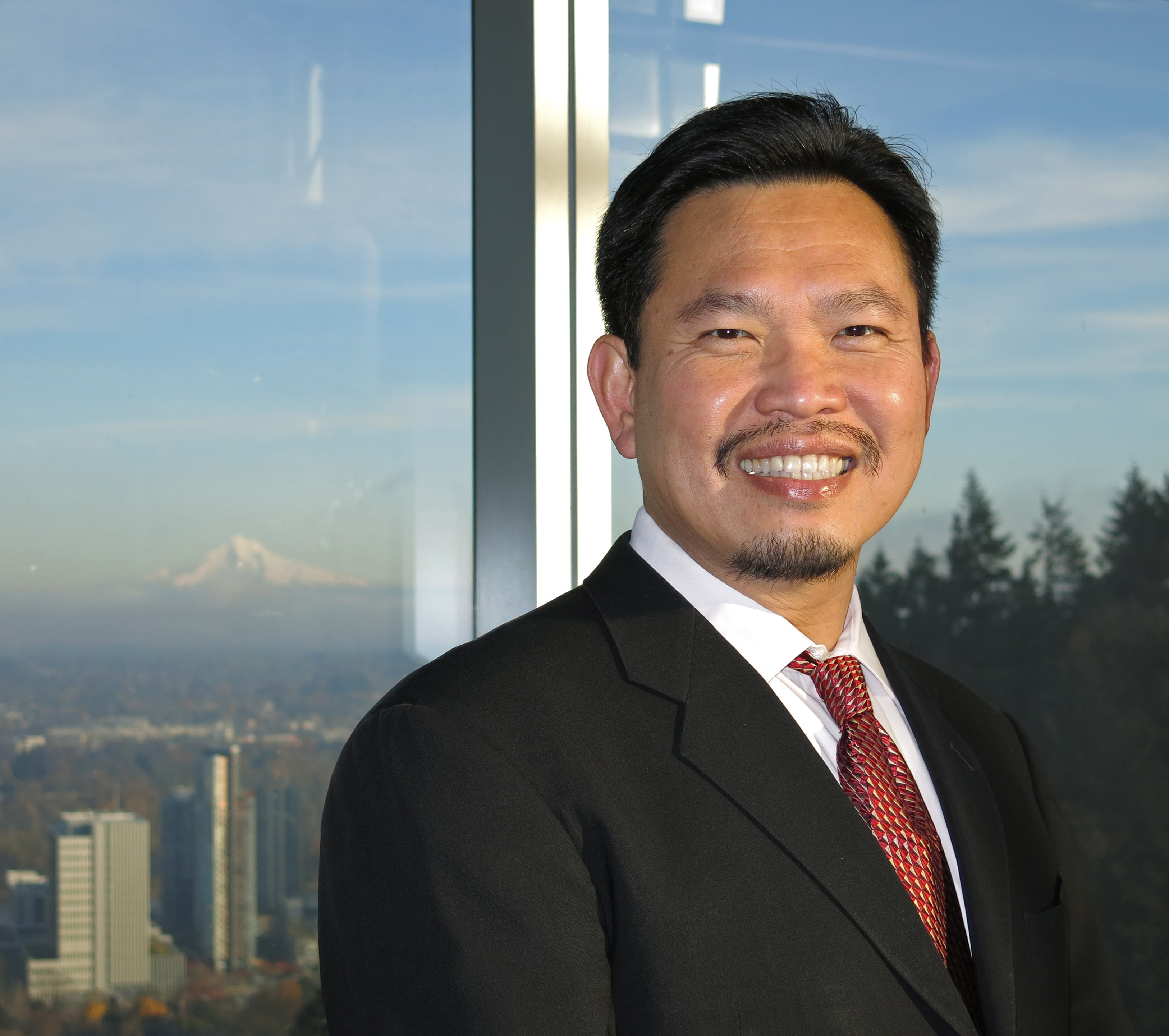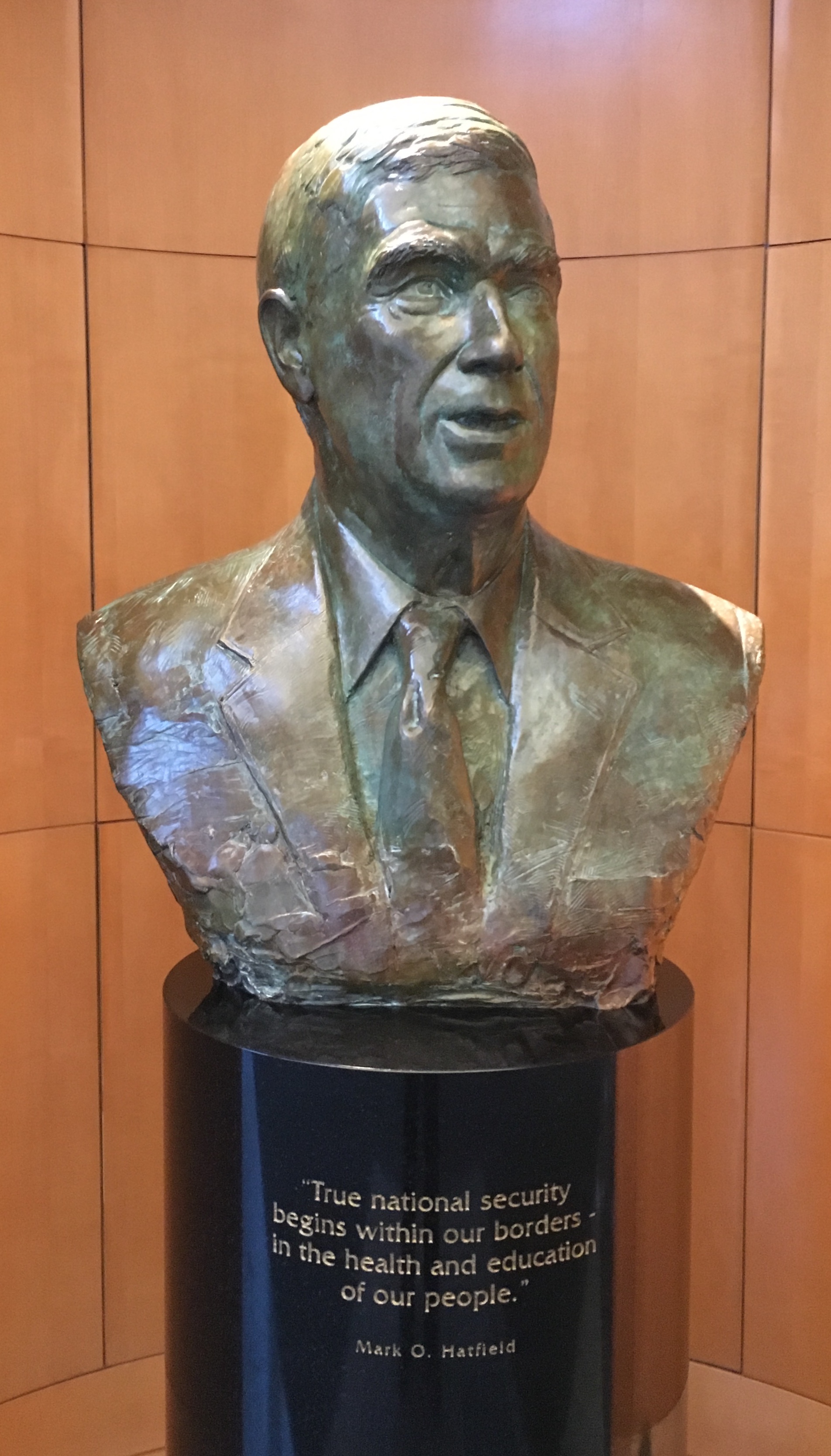Mark O. Hatfield Lecture
Seeing Small and Aiming Big

Tuesday, April 9, 2024
View the recording of the 2024 Hatfield lecture presented by Dr. David Huang.
David Huang, M.D., Ph.D., is a 2023 recipient of the National Medal of Technology and Innovation and the Lasker-DeBakey Clinical Medical Research Award. Dr. Huang is a co-inventor of optical coherence tomography (OCT), a precision ophthalmic imaging technology used more than 30 million times around the world each year.
In 1990, as a 26-year-old doctoral student at Harvard/MIT, Dr. Huang had the “aha” moment that led him, with colleagues James G. Fujimoto, Ph.D., and Eric A. Swanson, M.S., to invent the tool that has revolutionized the diagnosis and treatment of debilitating eye conditions. Dr. Huang and his lab are now pioneering uses for OCT in fighting not only diseases of the eye but the brain, the heart and more.
Today, Dr. Huang is the recipient of numerous international awards, author of more than 500 peer-reviewed articles and Director of Research at OHSU Casey Eye Institute, where he is a practicing ophthalmologist specializing in cornea and refractive surgery.
Dr. Huang’s journey from Taiwan to the most prestigious American research institutions and, with his co-inventors, to the White House to accept a National Medal of Technology and Innovation is a story of the best of academic medicine. It highlights the value of scientific collaboration that brings drive and fresh ideas together with mentorship and scholarship to advance health around the globe.
Dr. Huang is professor of ophthalmology and biomedical engineering at the OHSU School of Medicine and holds the Wold Family Endowed Chair in Ophthalmic Imaging at Casey Eye Institute. His original article on OCT, published in Science in 1991, has been cited more than 17,000 times. The holder of 38 U.S. patents, Dr. Huang is also cofounder of Gobiquity, maker of the GoCheck Kids smartphone app that has screened more than 5 million preschool children for amblyopia risk factors.
More about Dr. Huang’s work:
- National Science and Technology Medals Foundation video on the invention of OCT
- Dr. David Huang talks about optical coherence tomography
- Learn about optical coherence tomography from the Albert and Mary Lasker Foundation
-----------------------------------------------------------------------------------------------------
With gratitude to the estate and family of the late U.S. Senator Mark O. Hatfield for endowing this lectureship, Oregon Health & Science University is honored to invite the public and OHSU members to learn from Dr. Huang about the path of discovery, innovation and hope.
Mark O. Hatfield (1922-2011)

Mark Odom Hatfield was born July 12, 1922, in Dallas, Ore. His love for his country inspired him to join the U.S. Navy during World War II, shortly after receiving his B.A. from Willamette University in Salem, Ore. After the war, Hatfield completed his master's degree at Stanford University and returned to Willamette as a professor and eventually dean of students.
Hatfield launched his political career in 1950 with a successful run for the Oregon House of Representatives – he was then the youngest legislator in Oregon and still lived at his parents' home. In 1953 he introduced and passed legislation in the House prohibiting racial discrimination in public accommodations, before federal legislation and court decisions did so on a national level.
Hatfield then became the youngest Oregon Secretary of State in 1956, a two-term Oregon governor, then a U.S. Senator in 1966. As a senator and chairman of the Senate Appropriations Committee, Hatfield directed billions of dollars of federal appropriations to projects in Oregon.
After 30 years of service, Hatfield retired from the senate in 1996. He served on the OHSU Board of Directors from 2000 to 2008. He died August 7, 2011, following a lengthy illness.
Hatfield's legacy has been honored with buildings, organizations and wilderness areas around the state and country, including:
- Mark O. Hatfield Library at Willamette University
- Hatfield Marine Science Center at Oregon State University
- Hatfield School of Government at Portland State University
- Hatfield Research Center at OHSU
- Mark O. Hatfield U.S. Courthouse in Portland, Ore.
- Mark O. Hatfield Clinical Research Center at NIH in Bethesda, Md.
Event archive
Achieving Health Equity: Tools for a National Campaign Against Racism
Tuesday, Jan. 14, 2020
Camara Jones, M.D., M.P.H., Ph.D., Morehouse School of Medicine
Watch the recording of the 2020 Hatfield lecture presented by Dr. Camara Jones: "Achieving Health Equity: Tools for a National Campaign Against Racism"
Camara Phyllis Jones, M.D., M.P.H., Ph.D., is a family physician and epidemiologist whose work focuses on the impacts of racism on the health and well-being of the nation.
Her work over the course of her career has become public health canon, her lectures and writing are known to students and faculty across the country, and her insights have impacted practices in communities nationwide. Past president of the American Public Health Association, Dr. Jones is a Senior Fellow in the Satcher Health Leadership Institute and Cardiovascular Research Institute and an Adjunct Associate Professor in Community Health & Preventive Medicine at Morehouse School of Medicine and is currently a Radcliffe Fellow at the Radcliffe Institute for Advanced Study at Harvard University.
Dr. Jones seeks to broaden the national health debate to include not only universal access to high-quality health care but also attention to the social determinants of health (including poverty) and the social determinants of equity (including racism).
As a public health leader, Dr. Jones is valued for her creativity and intellectual agility. As a methodologist, she has developed new methods for comparing full distributions of data, rather than simply comparing means or proportions, in order to investigate population-level risk factors and propose population-level interventions. As a social epidemiologist, her work on "race"-associated differences in health outcomes goes beyond simply documenting those differences to vigorously investigating the structural causes of the differences.
Talks by Dr. Camara Jones:
Holding Fast to Dreams: Creating a Climate of Success for All Students in STEM and Beyond
April 9, 2018
Freeman Hrabowski, President, University of Maryland, Baltimore County
Rapid and dramatic demographic and technological changes present our nation with enormous challenges for educating students and preparing them for successful careers, particularly in science, technology, engineering, and math (STEM).
Freeman A. Hrabowski, III, Ph.D., president of the University of Maryland, Baltimore County, leads a campus widely recognized for its culture of embracing academic innovation to help students of all backgrounds succeed. He will draw on UMBC's experiences, along with three decades of studying minority student achievement nationwide, to discuss approaches for promoting inclusive excellence, academic innovation, and ultimately student success.
UMBC in the news:
- "Cinderella Story," The New York Times
- "The Secret Behind the Greatest Upset in College Basketball History," The Atlantic
Dr. Chu goes to Washington
A special presentation by the Marquam Hill Lecture Series
Presented by: Steven Chu, Ph.D. (April 23, 2013)
Human health and well-being depend on a healthy global environment. Steven Chu, Ph.D., discussed his vision of our energy future and how innovations in technology and public policy can help us/U.S. lead the world to a sustainable future. Dr. Chu is a distinguished scientist and co-winner of the Nobel Prize for Physics (1997). He served as the United States Secretary of Energy from January 2009 to April 2013.Prior to this appointment, Dr. Chu was director of the Lawrence Berkeley National Lab where he led the lab in pursuit of alternative and renewable energy technologies; he also taught at the University of California as a professor of physics and molecular and cell biology. He has returned to Stanford as a member of the Physics and Molecular and Cellular Physiology Departments.
OHSU concurrently welcomed Dr. Chu as a 125th anniversary lecturer.
The Value of Health: The Argument for Strong Investment in Medical and Scientific Research
A special presentation by Albert Starr, M.D.
March 15, 2012
The late Senator Hatfield was a tireless advocate for scientific and medical research and for Oregon’s system of higher education. That advocacy made possible the Oregon Health & Science University we know today. To honor his legacy, OHSU hosts an annual Mark O. Hatfield Lecture, delivered this year by Dr. Albert Starr. Dr. Starr came to OHSU in 1957 and led OHSU’s heart surgery program. He is best known for co-inventing and implanting the world’s first successful artificial heart valve, the Starr-Edwards Heart Valve, in 1960. Since then, the artificial heart valve technology has saved literally hundreds of thousands of lives.In his lecture, Dr. Starr discussed the importance of public support in the advancement of his own research – as well as that of OHSU – and examined the social and economic benefits of health and longevity.